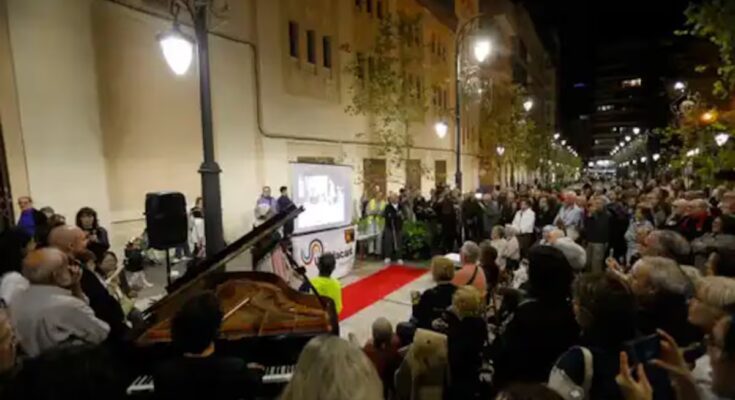The Ideal cinema in Alicante has been dying in stalemate since its closure in 2003. After an initial period of ups and downs by its former owners, it was finally sold in 2019 to a company that wants to turn it into a hotel. However, the processing of administrative permits and licenses is paralyzed. As well as its protection as an asset of cultural interest (BIC), requested on five occasions and claimed above all by the city platform Salvem l’Ideal, which wants it to be preserved and used for public and cultural uses. It has just turned one hundred years old, is located in the noble zone of the urban area, next to the Central Market or the Main Theater, and is the only survivor in the city of the most brilliant era of film exhibition as mass entertainment. Only some green netting protecting some ledges attests to the fact that he is still alive.
This weekend Salvem l’Ideal organized a party for the anniversary of the theater founded in 1925, at the height of the affirmation of silent cinema as the main attraction in the world of entertainment. After a complex procedure, the Municipality of Alicante allowed them to screen the first short film shown in the hall, Tribulationsby Harold Lloyd, on a small screen located next to the building’s facade, on the newly pedestrianized Avenida de la Constitución, accompanied by a live pianist, as in classical times. “We wanted to celebrate the centenary of the best example of cinematographic architecture in the Valencian Community”, explains Gonçal Ponç, spokesperson for the platform, “and claim its protection as a BIC, since its internal structure prevents any other use that is not cultural”.
In his opinion, the best solution would be “for the Generalitat to buy it”, an opportunity that the previous regional government, that of Botànic (on the basis of an agreement between PSOE, Compromís and Podemos), missed, “and for it to be redeveloped as a performance hall”, theater or headquarters of the Cineteca Valenciana in Alicante, “or as a cultural center for public use”. The Ministry of Culture confirms that “there is no news” regarding a dossier that the regional secretary of Culture, Pilar Tébar of Alicante, had already archived in her previous documents of 2024, requested by Salvem l’Ideal. The report of the Department of Urban Planning for the Catalog of Protections of Alicante, still provisional, which recommends the global protection of the Ideal as an “asset of historical, architectural and urban interest”, was of no use. “It could also be included in the Law on Historical Memory,” explains Ponç, “since during the Civil War the PCE intervened and after the fall of Alicante it became a detention center for female prisoners.”
With this consolidated protection, says Ponç, “the hotel would no longer be viable”. Although the idea of the current owner, the entrepreneur Trinitario Casanova, visible head of the Baraka real estate group, is very different. On its website it is announced as a future NH boutique hotel, with 61 rooms, restaurant, terrace cool and gym. The transformation would involve the demolition of the interior, where the main room without seats, two cantilevered amphitheaters and the box-like structures are still preserved, and the intervention on the facade. The administrative license request, submitted by the Baraka Group in 2019, is blocked.
“The building of the former Ideal cinema – declare municipal sources – is subject to obtaining the relevant authorizations from the Department of Culture and the Municipality to carry out the renovation of the property originally proposed by the ownership”. The construction company announced in May that it would file a complaint against Mayor Luis Barcala (PP) over the blockade. This newspaper attempted to contact Baraka, but received no response.
“The case of Alicante is anomalous, it is very strange that there is no clear decision to recover it,” says Jesús Ángel Sánchez García, professor of History of Art at the University of Santiago de Compostela (USC) and coordinator of the inventory of cinemas for the new National Plan of Contemporary Architecture of the Ministry of Culture.
Sánchez García classifies cinemas “with architectural values that still exist” throughout the country “and the Ideal is one of the most appreciated”, he claims. Among other things for its “exceptional” orchestral pit, intended for shows requiring live music.
Born as Cinema Ideale in 1925, it bears the signature of the architect Juan Vicente Santafé. The premiere was shown, according to the inaugural invitation, of the “sensational film in five parts” That damn moneystarring Gladys Hulette and Creigton Hale, which is probably a lost film from the original title For sale and directed by Fred E. Wright in 1918. Along with her, the Tribulations of the “nice SE”, as Harold Lloyd was then known.
“Throughout Spain there are many examples of properties recovered and in good use”, mostly intended “for cinema or theater shows, or even cultural centres” and in a smaller portion “for other uses”, explains the specialist. Born in the 1920s, they respond to “a typology of multifunctional theatres” in which “theater, zarzuela and variety shows” were programmed and in which “cinema took on ever more importance”.
A 1913 law plunged these infrastructures, restored or new, into modernity. «They were built with reinforced concrete structures, with internal configuration solutions that allowed large capacities», like that of the Ideal, which had almost 1,500 seats. “The rooms were more comfortable, with wider entrances, corridors, escape doors and staircases.” In just a decade they would quickly adapt to the technical demands of sound cinema. “They contributed to making the city”, continues Sánchez García, “the structures, the billboards, the lights attracted spectators in an era when people still walked through the urban centre”.
Outside of the large capitals, among the most relevant examples of the time, the USC professor highlights the Ideal Theater in Calahorra, the Palacio Valdés Theater in Avilés, the Gullón in Astorga, the Darymelia in Jaén and the Villamarta in Jerez, all recovered for scenic purposes. Others come back to life as cultural centers, such as “the Central cinema in Cartagena or the Palacio de la Música in Madrid, currently under construction”. And a small percentage goes to nightclubs, bingo halls, bank offices or clothing stores. And lately to hotels, “like the Bellas Artes de San Sebastián, a pioneering cinema from 1914, which they have renovated” with important interventions also on the facade. “There is a lack of effective urban protection to safeguard these properties,” complains Sánchez García.



